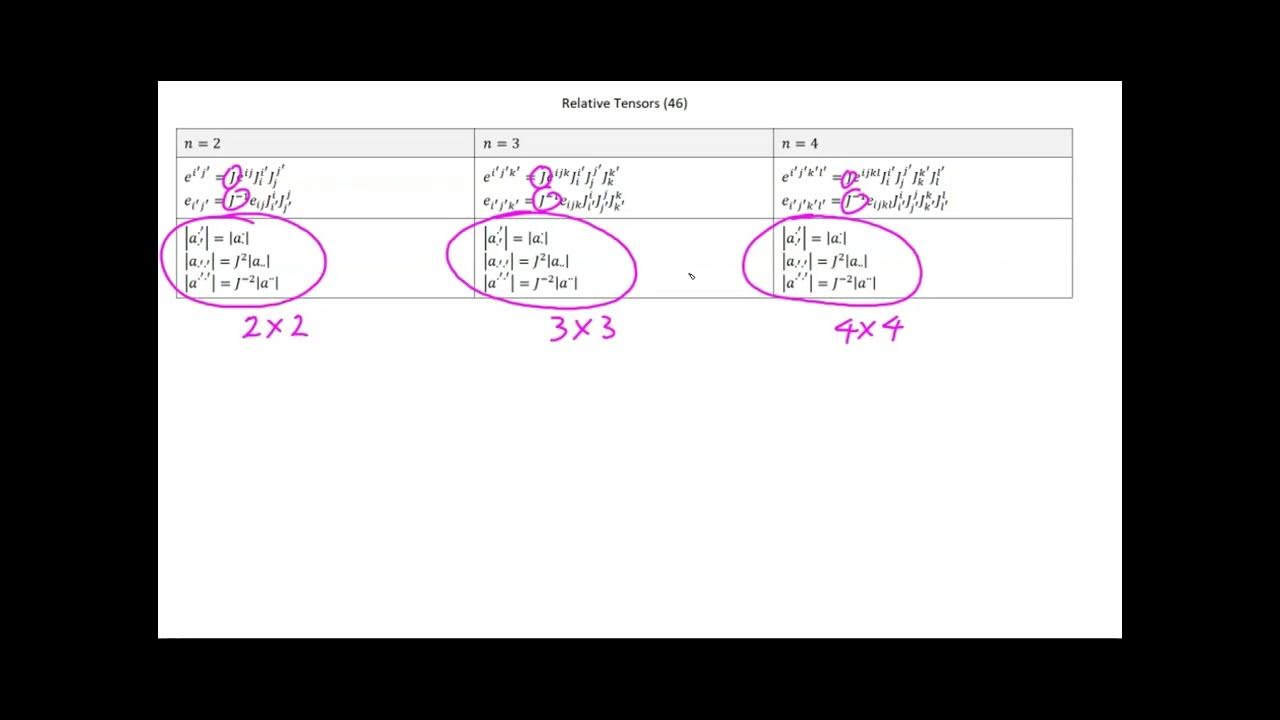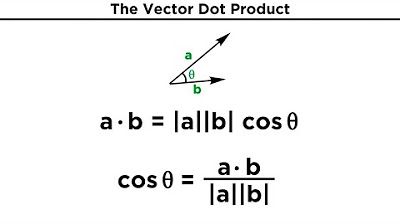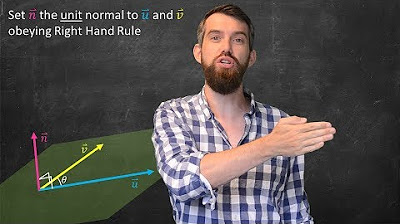why there is no four dimensional cross product.
TLDRThe video script delves into the concept of cross products in various dimensions, a topic often pondered by students studying multivariable calculus or physics. It begins by establishing the axioms that define a cross product in n-dimensional space, emphasizing skew symmetry, distributivity over addition, and bilinearity. The script then explores the properties of cross products, particularly their ability to produce orthogonal vectors, as exemplified by the zero dot product of a vector and its cross product with another. Through a series of logical steps and mathematical proofs, the video demonstrates that cross products exist trivially in one-dimensional space, are well-defined in three-dimensional space, and surprisingly in seven-dimensional space through the octonions. However, it is proven that there cannot be a cross product in two, four, five, or six-dimensional spaces due to contradictions that arise when applying the established axioms. The script concludes by showing that for dimensions higher than seven, a cross product is also impossible, thus confirming that the only spaces with a valid cross product are one, three, and seven dimensions.
Takeaways
- 📚 The concept of a cross product is often introduced in multivariable calculus or physics classes, and it is known to exist in three-dimensional space.
- ❓ The question arises whether a cross product can be extended to higher dimensions, such as four or five dimensions.
- 🔍 A 1967 paper from the American Mathematical Monthly provides an elementary approach to understanding the conditions for a cross product in any given dimension.
- 📏 The cross product must satisfy certain axioms, including skew symmetry, distributivity over addition, scalar multiplication, and bilinearity.
- 🟢 Cross products are known to produce orthogonal vectors, meaning the dot product of two vectors A and B is zero if A is the cross product of B with another vector.
- 🚫 In one-dimensional space (R1), the cross product is trivially zero for any two vectors, as the only vector that is its own negative is the zero vector.
- ❌ In two-dimensional space (R2), a cross product does not exist because it leads to a contradiction when trying to satisfy the required properties.
- 🌐 In three-dimensional space (R3), the cross product is well-defined and follows the right-hand rule, producing a vector perpendicular to the plane formed by the two input vectors.
- 📉 The video demonstrates that for dimensions higher than three, specifically in R4, R5, and R6, a cross product cannot exist due to the properties of vector spaces and their orthogonal complements.
- 📈 Interestingly, a cross product does exist in seven-dimensional space (R7), defined in terms of the octonians and related to a specific geometric structure.
- 🚧 For dimensions higher than seven, the video concludes that a cross product is not possible, as it would violate the properties of vector spaces and their orthogonal complements.
- 🧮 The final takeaway is that cross products are only defined in one-dimensional, three-dimensional, and seven-dimensional spaces, which is a significant result in understanding the algebraic structure of vector spaces.
Q & A
What is the purpose of defining axioms for a cross product?
-The axioms for a cross product are defined to ensure that any operation deemed a cross product adheres to a set of rules that emulate the characteristics of the familiar three-dimensional cross product. These axioms include properties like skew-symmetry, bilinearity, and the ability to produce orthogonal vectors, which are essential for its mathematical and practical applications in vector spaces.
How is the cross product related to orthogonality in vector spaces?
-One key property of the cross product is its ability to produce vectors that are orthogonal to the original vectors involved in the operation. Mathematically, this is expressed as the dot product of a vector and its cross product with another vector being zero, symbolizing that they are perpendicular to each other.
Why does a cross product not exist in two-dimensional space?
-In two-dimensional space, the cross product does not exist because there is no third dimension to accommodate a vector that is orthogonal to both vectors in the operation. As demonstrated in the script, attempts to define such a product lead to contradictions, such as asserting a vector is orthogonal to itself, which is not possible.
What are the only dimensions in which a cross product can exist, as described in the script?
-According to the script, a cross product can only exist in one-dimensional, three-dimensional, and seven-dimensional spaces. These are the only dimensions where the properties defined by the axioms of the cross product can be consistently applied without leading to mathematical inconsistencies or contradictions.
How is the cross product in seven-dimensional space related to the octonions?
-The seven-dimensional cross product is closely related to the algebra of the octonions, which are a non-associative extension of the quaternions. This relationship is characterized by specific rules governing the cross product operations among the basis vectors, resembling the multiplication rules of octonions.
What is meant by a subspace being 'cross stable'?
-A subspace is termed 'cross stable' if for any vectors a and b within that subspace, their cross product also belongs to the same subspace. This concept is akin to the idea of an ideal in ring theory, where the product of any elements within the ideal and the ring still results in elements that are within the ideal.
What does the script imply about cross products in dimensions higher than seven?
-The script concludes that cross products cannot exist in dimensions higher than seven. This conclusion is based on deriving a contradiction when attempting to define a cross product in dimensions greater than seven, leading to logical impossibilities under the established axioms.
How does associativity relate to the cross product?
-The cross product is inherently non-associative, meaning that the order of operations affects the outcome. This non-associativity is critical in various mathematical proofs and manipulations involving cross products, distinguishing it from dot products, which are associative.
Can the distributive property be applied to the cross product?
-Yes, the distributive property applies to the cross product, allowing it to distribute over addition. This means that the cross product of a vector with the sum of two vectors equals the sum of the cross product with each vector individually. This property is essential for expanding and simplifying expressions involving cross products.
What role does skew-symmetry play in defining a cross product?
-Skew-symmetry, also known as anti-commutativity, is crucial in defining the cross product, stating that reversing the order of vectors in a cross product results in the original cross product negated. This property is fundamental in ensuring the cross product's behavior aligns with the geometric interpretation of area and orientation in vector spaces.
Outlines
🤔 Introduction to the Cross Product and its Higher Dimensional Existence
The video begins with a discussion on the cross product, a mathematical concept often encountered by students in multivariable calculus or physics. The presenter addresses the common question of whether a cross product exists in dimensions other than three. The video aims to explore if there's a four-dimensional cross product or higher and uses a 1967 paper from the American Mathematical Monthly as a starting point. The presenter outlines the axioms that a cross product should satisfy, such as skew symmetry, bilinearity, and the ability to produce orthogonal vectors. The exploration starts by examining the smallest dimensions, beginning with one-dimensional space.
🔍 Examining Cross Products in One and Two-Dimensional Spaces
The video explores the properties of the cross product in one-dimensional (R1) and two-dimensional (R2) spaces. It is shown that in R1, the cross product is trivially defined and equals zero, as any two vectors are collinear. However, in R2, a contradiction arises when trying to apply the same properties, leading to the conclusion that a cross product does not exist in two-dimensional space. The presenter uses the axioms of the cross product to derive these results and highlights the importance of the cross product's ability to produce orthogonal vectors.
📐 The Familiar Three-Dimensional Cross Product
The video then delves into the three-dimensional cross product, which is well-known and taught in various classes. The presenter describes the cross product in three dimensions using a set of mutually orthogonal unit vectors (E1, E2, E3) and demonstrates the rules governing the cross product in this space. The video uses a visual representation to show how the cross product operates in three dimensions, emphasizing the cyclic nature of the cross product between these basis vectors.
🧩 Proving Cross Product Properties and Non-Associativity
The presenter proves several properties and rules associated with the cross product using the axioms previously outlined. These include the non-associativity of the cross product and how it interacts with the dot product. The video uses algebraic manipulation to show that the cross product of A and B dotted with C is equal to B dotted with the cross product of A and C. This section provides a deeper understanding of the algebraic structure of the cross product.
🚧 Cross-Stable Subspaces and Their Orthogonal Complements
The concept of cross-stable subspaces is introduced, where a subspace B is considered cross-stable if the cross product of any vectors within B remains in B. The video proves that if a subspace B is cross-stable, then its orthogonal complement is also cross-stable. The presenter uses this property to explore the dimensions of subspaces and their orthogonal complements in the context of the cross product.
🏗️ Constructing a Seven-Dimensional Cross Product
The video constructs a seven-dimensional cross product using the properties of a three-dimensional cross product and extends it into higher dimensions. The presenter shows that it is possible to create a subspace within a higher-dimensional space that mimics the behavior of the three-dimensional cross product. This construction leads to the discovery of a cross product in seven-dimensional space (R7), which is not immediately obvious from the properties of the three-dimensional case.
🚫 Non-Existence of Cross Products in Dimensions Higher Than Seven
The presenter concludes by proving that no cross product can exist in dimensions higher than seven. Using the properties of the cross-stable subspaces and their orthogonal complements, the video shows that the existence of such a product in higher dimensions would lead to a contradiction. This proof involves constructing a specific set of vectors in the hypothetical cross product space and demonstrating that it is impossible for the cross product to satisfy all the required properties simultaneously, thus confirming that only one-, three-, and seven-dimensional cross products are possible.
Mindmap
Keywords
💡Cross Product
💡Skew Symmetry
💡Bilinearity
💡Orthogonal Vectors
💡Dot Product
💡One-Dimensional Space
💡Two-Dimensional Space
💡Three-Dimensional Space
💡Higher-Dimensional Space
💡Seven-Dimensional Space
💡Orthonormal Basis
Highlights
The video explores the existence of cross products in dimensions other than three, focusing on the possibility of a four-dimensional cross product.
The presenter outlines the axioms that a cross product should satisfy, including skew symmetry, distributivity over addition, and bilinearity.
It is shown that in one-dimensional space, the cross product is trivially zero for any pair of vectors.
A contradiction is derived for a two-dimensional cross product, proving that it does not exist.
The familiar three-dimensional cross product is reviewed, including its properties and geometric interpretation.
The video presents a proof that no cross product exists in four, five, or six-dimensional spaces based on the dimensions of orthogonal complements.
A seven-dimensional cross product is introduced, defined in terms of a Heisenberg plane and octonians.
The presenter demonstrates that for dimensions higher than seven, a cross product is not possible, leading to a contradiction.
A detailed mathematical proof is provided to show why a cross product cannot exist in spaces of dimensions other than one, three, and seven.
The video concludes that only one-, three-, and seven-dimensional spaces support a cross product.
The concept of cross stability is introduced as a condition for a subspace to maintain the cross product operation.
The orthogonal complement of a cross-stable subspace is also shown to be cross-stable.
An orthonormal basis for a subspace closed under the cross product is discussed in relation to the orthogonal complement.
The video uses the properties of the dot and cross products to derive new relationships and rules.
A geometric interpretation of the cross product in higher dimensions is attempted, leading to insights about its limitations.
The non-associativity of the cross product is highlighted through various mathematical manipulations.
The video provides a comprehensive exploration of the algebraic structure of cross products in different dimensional spaces.
Transcripts
Browse More Related Video

Calculus 3: Lecture 11.4 The Cross Product of Two Vectors in Space

Calculus 3: The Cross Product (Video #4) | Math with Professor V

How to Calculate the Vector Cross Product

Video 55 - Generalization to Other Dimensions

The Vector Dot Product

Geometrically Defining the Cross Product | Multivariable Calculus
5.0 / 5 (0 votes)
Thanks for rating: